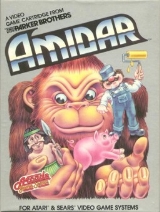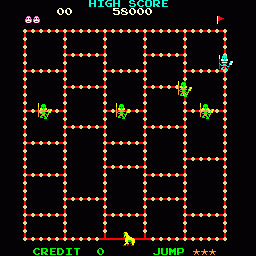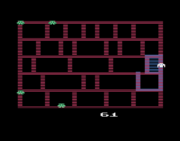
Amidar
Encyclopedia
- For the Israeli government-operated housing firm, see AmidarAmidar (Company)Amidar is a state-owned housing company in Israel.The company was founded in 1949. Its mission statement is "to be involved in construction projects, development, population and maintenance in Israel"...
Amidar is an arcade game
Arcade game
An arcade game is a coin-operated entertainment machine, usually installed in public businesses such as restaurants, bars, and amusement arcades. Most arcade games are video games, pinball machines, electro-mechanical games, redemption games, and merchandisers...
programmed by Konami
Konami
is a Japanese leading developer and publisher of numerous popular and strong-selling toys, trading cards, anime, tokusatsu, slot machines, arcade cabinets and video games...
and published in 1981 by Stern. Its basic format is similar to that of Pac-Man
Pac-Man
is an arcade game developed by Namco and licensed for distribution in the United States by Midway, first released in Japan on May 22, 1980. Immensely popular from its original release to the present day, Pac-Man is considered one of the classics of the medium, virtually synonymous with video games,...
: the player moves around a fixed rectilinear
Rectilinear
Rectilinear may refer to:* Rectilinear grid, a tessellation of the Euclidean plane* Rectilinear lens, a photographic lens* Rectilinear locomotion, a form of animal locomotion* Rectilinear polygon, a polygon whose edges meet at right angles...
lattice, attempting to visit each location on the board while avoiding the enemies. When each spot has been visited, the player moves to the next level.
The game and the name have their roots in the Japanese lot drawing game Amidakuji. The bonus level in Amidar is a nearly exact replication of an Amidakuji game and the way the enemies move conform to the Amidakuji rules. A clone of this game was released for the Atari 2600, entitled Spiderdroid
Spiderdroid
Spiderdroid is a 1983 video game for the Atari 2600.It was a clone of Amidar with a more futurisic setting. The object of the game is to fill in boxes that have to be made by moving by its four corners. There is similarity to Pac-Man also...
.
Gameplay

On odd-numbered levels, the player controls an ape
Ape
Apes are Old World anthropoid mammals, more specifically a clade of tailless catarrhine primates, belonging to the biological superfamily Hominoidea. The apes are native to Africa and South-east Asia, although in relatively recent times humans have spread all over the world...
(in some versions labeled "Copier"), and must collect coconuts while avoiding headhunter
Headhunting
Headhunting is the practice of taking a person's head after killing them. Headhunting was practised in historic times in parts of China, India, Nigeria, Nuristan, Bangladesh, Myanmar, Borneo, Indonesia, the Philippines, Taiwan, Japan, Micronesia, Melanesia, New Zealand, and the Amazon Basin, as...
s (labeled "Police" and "Thief"). On even-numbered levels, the player controls a paint roller (labeled "Rustler"), and must paint over each spot of the board while avoiding pig
Pig
A pig is any of the animals in the genus Sus, within the Suidae family of even-toed ungulates. Pigs include the domestic pig, its ancestor the wild boar, and several other wild relatives...
s (labeled "Cattle" and "Thief"). Each level is followed by a short bonus stage
Bonus stage
A bonus stage is a special level within a video game designed to reward the player or players, and typically allows the player to collect extra points or power-ups. Often a bonus stage will have no enemies or hazards, or may contain them but the player character is invulnerable to attack from them...
.
Whenever a rectangular portion of the board is cleared (either by collecting all surrounding coconuts, or painting all surrounding edges), the rectangle is colored in, and in the even levels, bonus points are awarded. This leads to some comparisons with the popular and influential Qix
Qix
Qix is an arcade game, released by Taito America Corporation in 1981.-Gameplay:The objective of Qix is to fence off, or “claim”, a supermajority of the playfield...
, although the similarities between these games are superficial at best. When the player clears all four corners of the board, he is briefly empowered to kill the enemies by touching them (just as when Pac-Man uses a "power pill").
The game controls consist of a joystick and a single button labeled "Jump," which can be used up to three times, resetting after a level is cleared or the player loses a life. Pressing the jump button does not cause the player to jump, but causes all the enemies to jump, enabling the player to walk under them.
Enemy movement
The enemies (and bonus stage pigs) in Amidar move deterministicDeterministic algorithm
In computer science, a deterministic algorithm is an algorithm which, in informal terms, behaves predictably. Given a particular input, it will always produce the same output, and the underlying machine will always pass through the same sequence of states...
ally; this is described in the game as "Amidar movement". Each normal-type enemy moves vertically from the top to the bottom of the screen, and then back to the top, and so on. While moving in a constant vertical direction, the enemy will take every horizontal turn available. Each level has one special enemy (the "Tracer", colored white) which, at the beginning of each stage, simply patrols around the perimeter of the gameboard in an anti-clockwise direction. However, following a certain number of "laps", The Tracer will begin to relentlessly pursue the player by following the path their on-screen avatar takes around the level. Since the Tracer moves at the same speed as the player character, but does not mimic any pauses or hesitations the player makes, gameplay now becomes much more frantic, as too many mistakes will allow the Tracer to catch up. Later levels increase difficulty by adding more complex game grids, adding more enemies, and reducing the delay before the Tracer starts pursuing the player, until eventually it starts its pursuit after a single lap at the beginning of each new level.
Level differences
The even-numbered levels where the player controls a paint roller are somewhat more difficult, because the paint roller cannot move too far from grid rectangles that have already been filled without running out of paint and having to return to completed parts of the map to refresh its supply. When this happens, any painted lines which are not part of a filled rectangle will vanish and must be painted again. In practical terms, this means that the player must build their completed squares around the starting point of the level (which always has a fresh supply of paint) and spread outwards, rather than completing squares in any part of the game board they please, as they can on the odd-numbered levels. This also makes filling the corner rectangles and becoming invincible much more difficult.Ports and clones

Atari 2600
The Atari 2600 is a video game console released in October 1977 by Atari, Inc. It is credited with popularizing the use of microprocessor-based hardware and cartridges containing game code, instead of having non-microprocessor dedicated hardware with all games built in...
by Parker Brothers
Parker Brothers
Parker Brothers is a toy and game manufacturer and brand. Since 1883, the company has published more than 1,800 games; among their best known products are Monopoly, Cluedo , Sorry, Risk, Trivial Pursuit, Ouija, Aggravation, and Probe...
. This was the only official port but as with most arcade games of the time, there were many unofficial clones for home computers including Acornsoft
Acornsoft
Acornsoft was the software arm of Acorn Computers Ltd, and a major publisher of software for the BBC Micro and Acorn Electron. As well as games, they also produced a large number of educational titles, extra computer languages and business and utility packages - these included ROM-based word...
's Crazy Tracer (BBC Micro
BBC Micro
The BBC Microcomputer System, or BBC Micro, was a series of microcomputers and associated peripherals designed and built by Acorn Computers for the BBC Computer Literacy Project, operated by the British Broadcasting Corporation...
, Acorn Electron
Acorn Electron
The Acorn Electron is a budget version of the BBC Micro educational/home computer made by Acorn Computers Ltd. It has 32 kilobytes of RAM, and its ROM includes BBC BASIC along with its operating system....
), Microdeal
Microdeal
Microdeal was a British software company which operated during the 1980s and early 1990s from its base at Truro Road in the town of St Austell, Cornwall...
's Cuthbert Goes Walkabout
Cuthbert Goes Walkabout
Cuthbert Goes Walkabout is a 1983 computer game for the Dragon 32/64, TRS-80 CoCo, Commodore 64 and Atari 8-bit family home computers. Produced by Microdeal, the game features the hero Cuthbert . The game is based on the Konami arcade game Amidar...
(Dragon 32/64
Dragon 32/64
The Dragon 32 and Dragon 64 are home computers that were built in the 1980s. The Dragons are very similar to the TRS-80 Color Computer , and were produced for the European market by Dragon Data, Ltd., in Port Talbot, Wales, and for the US market by Tano of New Orleans, Louisiana...
, TRS-80 CoCo
TRS-80 Color Computer
The Radio Shack TRS-80 Color Computer was a home computer launched in 1980. It was one of the earliest of the first generation of computers marketed for home use in English-speaking markets...
, Commodore 64
Commodore 64
The Commodore 64 is an 8-bit home computer introduced by Commodore International in January 1982.Volume production started in the spring of 1982, with machines being released on to the market in August at a price of US$595...
, Atari 8-bit family
Atari 8-bit family
The Atari 8-bit family is a series of 8-bit home computers manufactured from 1979 to 1992. All are based on the MOS Technology 6502 CPU and were the first home computers designed with custom coprocessor chips...
), Llamasoft's Traxx (Vic-20, ZX Spectrum
ZX Spectrum
The ZX Spectrum is an 8-bit personal home computer released in the United Kingdom in 1982 by Sinclair Research Ltd...
), Superior Software
Superior Software
Superior Software is a video game publisher. It was established in 1982 by Richard Hanson and John Dyson, two graduates of the University of Leeds, England...
's Crazy Painter (BBC Micro
BBC Micro
The BBC Microcomputer System, or BBC Micro, was a series of microcomputers and associated peripherals designed and built by Acorn Computers for the BBC Computer Literacy Project, operated by the British Broadcasting Corporation...
) and Gapper and Rollo And The Brush Bros
Rollo And The Brush Bros
Rollo And The Brush Bros was originally created by Windmill software in 1984 and released as a copy-protected, bootable 5.25" floppy disk for the IBM PC/XT...
(DOS
DOS
DOS, short for "Disk Operating System", is an acronym for several closely related operating systems that dominated the IBM PC compatible market between 1981 and 1995, or until about 2000 if one includes the partially DOS-based Microsoft Windows versions 95, 98, and Millennium Edition.Related...
).
Gakken
Gakken
is a Japanese publishing company founded in 1947 by Hideto Furuoka, which also produces educational toys. Their annual sales is reported at ¥ 821 billion ....
made a table top hand held game of Amidar in 1982. It was one of a series of 3 flip-top games with VFD
Vacuum fluorescent display
A vacuum fluorescent display is a display device used commonly on consumer-electronics equipment such as video cassette recorders, car radios, and microwave ovens. Invented in Japan in 1967, the displays became common on calculators and other consumer electronics devices...
screen and magnifying Fresnel lens
Fresnel lens
A Fresnel lens is a type of lens originally developed by French physicist Augustin-Jean Fresnel for lighthouses.The design allows the construction of lenses of large aperture and short focal length without the mass and volume of material that would be required by a lens of conventional design...
. The other two similar style Gakken hand held games were Jungler
Jungler
Jungler is a maze-based arcade game developed by Konami in 1981. Distributed by Stern in the United States beginning in 1982, the game has players controlling a multi-segmented creature attempting to destroy similar enemy creatures by either shooting them or eating them.-Gameplay:In Jungler, the...
and Dig Dug
Dig Dug
is an arcade game developed and published by Namco in Japan in 1982 for Namco Galaga hardware. It was later published outside of Japan by Atari. A popular game based on a simple concept, it was also released as a video game on many consoles.-Objective:...
. In 2010 Kenneth Dyrlund made a clone of Amidar located af http://www.kenneth-dyrlund.dk/musik/amidar1-b.html
Competition
There are two known ROM sets for Amidar, a harder version distributed by Stern and an easier set created by Konami. According to Twin GalaxiesTwin Galaxies
Twin Galaxies is an American organization that tracks video game world records and conducts a program of electronic-gaming promotions. It operates the Twin Galaxies website and publishes the Twin Galaxies' Official Video Game & Pinball Book of World Records, with the Arcade Volume released on June...
, Scott Karasek, of Racine, Wisconsin, USA, scored a world record 3,208,870 points on the Stern ROM set on June 22, 1982. On the Konami ROM set, Todd Lamb reached 19,225,030 points in Kenosha, Wisconsin, USA, on October 1, 1983.
External links
- Amidar at Arcade-History

